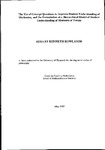The Use of Concept Questions to Improve Student Understanding of Mechanics, and the Formulation of a Hierarchical Model of Student Understanding of Moments of Forces
| dc.contributor.author | ROWLANDS, STUART KENNETH | |
| dc.contributor.other | School of Engineering, Computing and Mathematics | en_US |
| dc.date.accessioned | 2013-10-11T08:40:45Z | |
| dc.date.available | 2013-10-11T08:40:45Z | |
| dc.date.issued | 1997 | |
| dc.identifier | NOT AVAILABLE | en_US |
| dc.identifier.uri | http://hdl.handle.net/10026.1/2161 | |
| dc.description.abstract |
The aims and objectives of the first part of the thesis are to create and evaluate a teaching package that would enable the teacher to facilitate student conceptual understanding of mechanics. The second part is to create a hierarchical model of student conceptual understanding of moments of forces. The thesis reports on the various conflicting theories and recommended teaching strategies from the research into student misconceptions, and examines the various underlying philosophical trends (for example, radical and social constructivism, the Vygotskian perspective and positivism) that have influenced the research into misconceptions in mechanics. As a result, the philosophical perspective of the thesis is that the analysis of the structure of Newtonian mechanics ought to be before the consideration of challenging misconceptions. The question as to how students can construct for themselves the Newtonian system ought to be prior to the consideration of designing a strategy to tackle misconceptions. With prior consideration of the structure of mechanics, the thesis examines the formation of the intuitive schema of force and motion. The thesis proposes the Socratic method of strategic questioning as the most appropriate teaching method for constructing the Newtonian system and displacing the intuitive schema of force and motion. The thesis reports on the formation, and the evaluation, of the teaching package as an aid to facilitate the construction of the Newtonian system, and concludes that teachers have to be trained in the use of the Socratic method prior to any evaluation. There has been little or no research in the area of misconceptions concerning moments. The thesis reports on the formation of a hierarchical model of understanding moments. From a sample of 417 students nation-wide, the thesis has identified 3 conceptual levels of understanding moments and discusses the teaching implications based on the responses from the sample. | en_US |
| dc.language.iso | en | en_US |
| dc.publisher | University of Plymouth | en_US |
| dc.title | The Use of Concept Questions to Improve Student Understanding of Mechanics, and the Formulation of a Hierarchical Model of Student Understanding of Moments of Forces | en_US |
| dc.type | Thesis | |
| dc.identifier.doi | http://dx.doi.org/10.24382/4697 | |
| dc.identifier.doi | http://dx.doi.org/10.24382/4697 |
Files in this item
This item appears in the following Collection(s)
-
01 Research Theses Main Collection
Research Theses Main


